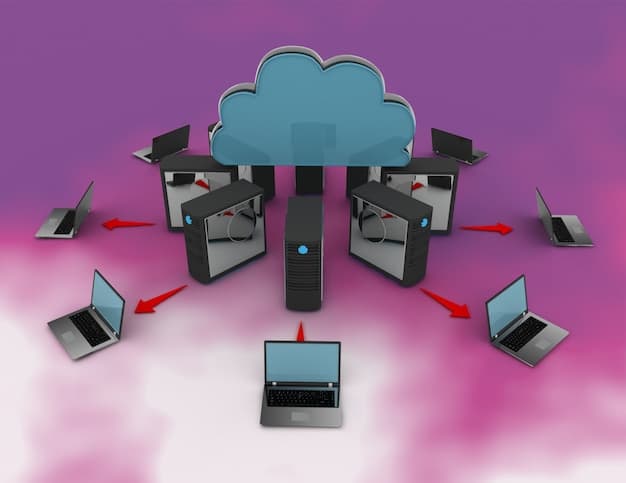US Cybersecurity Spending: Why It’s Growing 18% by 2025

The projected 18% growth in US cybersecurity spending by 2025 is primarily driven by escalating cyber threats, an expanding digital attack surface, stricter regulatory compliance requirements, and a growing enterprise recognition of cybersecurity as a critical business imperative.
The landscape of digital security is evolving at an unprecedented pace, marked by both innovation and escalating threats. Understanding what’s driving the projected 18% growth in US cybersecurity spending by 2025 is crucial for businesses, governments, and individuals alike. This significant increase underscores a fundamental shift in how organizations perceive and prioritize digital protection, transforming it from a mere IT overhead into a strategic imperative.
The Escalating Threat Landscape
The digital world has become inextricably linked to our daily lives and global economy, but this convenience comes with inherent risks. Cyber threats are no longer isolated incidents but sophisticated, coordinated attacks originating from various state-sponsored groups, organized crime syndicates, and individual malicious actors. The sheer volume and complexity of these threats necessitate a robust and evolving defense strategy, directly contributing to the surge in cybersecurity investments.
One of the most persistent threats involves ransomware, which has moved beyond individual users to targeting critical infrastructure, healthcare systems, and large corporations. The financial and operational damage inflicted by successful ransomware attacks can be catastrophic, leading organizations to invest heavily in preventative measures, rapid detection tools, and sophisticated recovery plans. The cost of prevention, in many cases, is far outweighed by the potential cost of a breach, driving increased spending.
Sophistication of Attack Vectors
Attackers are constantly refining their methodologies, leveraging advanced techniques such as AI-powered phishing, supply chain compromises, and zero-day exploits. This sophistication demands equally advanced defensive capabilities, requiring organizations to continuously update their security protocols and technologies. The arms race between attackers and defenders is a primary catalyst for the sustained growth in cybersecurity expenditure.
- AI-Powered Attacks: Malicious actors are using artificial intelligence to automate credential theft, craft highly convincing phishing emails, and bypass traditional security measures.
- Supply Chain Vulnerabilities: Compromising a single vendor can expose an entire network of clients, as seen in numerous high-profile breaches, compelling businesses to scrutinize and secure their extended supply chains.
- Zero-Day Exploits: These are vulnerabilities unknown to software vendors, allowing attackers to penetrate systems before patches are available, making proactive threat hunting and rapid response vital.
The ongoing digitization of business operations further broadens the attack surface, creating more entry points for cybercriminals. As more processes, data, and interactions migrate online, the opportunities for exploitation multiply. This expansion, coupled with the increasing profitability of cybercrime, creates a compelling case for heightened cybersecurity spending across all sectors.
Expanded Digital Footprint and Cloud Adoption
The rapid adoption of cloud computing, the proliferation of Internet of Things (IoT) devices, and the shift to remote and hybrid work models have dramatically expanded the digital footprint of organizations. While offering immense benefits in terms of flexibility and scalability, this expanded footprint also introduces new vulnerabilities and complexities that demand increased cybersecurity investments to mitigate risks.
Cloud environments, whether public, private, or hybrid, require specialized security considerations. Unlike traditional on-premises infrastructures, cloud security is a shared responsibility between the cloud provider and the client. Organizations must invest in cloud access security brokers (CASBs), cloud security posture management (CSPM) tools, and expertise to ensure data stored and processed in the cloud remains secure, compliant, and visible.
IoT and Edge Computing
The explosion of IoT devices, from smart sensors in manufacturing to connected medical devices, significantly broadens the attack surface. Many IoT devices are developed with functionality over security as a priority, making them attractive targets for attackers seeking entry into a network. Securing these numerous, often geographically dispersed devices, requires dedicated solutions and substantial investment.
- Device Vulnerabilities: Many IoT devices have weak default passwords or unpatched vulnerabilities, making them easy targets for botnets and other nefarious activities.
- Network Segmentation: Isolating IoT devices on separate network segments is crucial to prevent breaches from spreading to critical business systems.
- Edge Security: As processing moves closer to the data source (edge computing), securing these distributed nodes becomes a complex and costly endeavor.

The widespread shift to remote and hybrid work environments, accelerated by recent global events, has further complicated cybersecurity. Employees accessing corporate resources from diverse locations using personal and company devices introduce new vectors for attack. This necessitates robust endpoint detection and response (EDR) solutions, secure access service edge (SASE) frameworks, and comprehensive employee training programs, all contributing to the rising cybersecurity expenditure.
Stricter Regulatory Compliance and Data Privacy
Beyond the direct threat of cyberattacks, organizations are increasingly driven to invest in cybersecurity due to a growing web of stringent regulatory compliance requirements and data privacy laws. Governments worldwide are enacting and enforcing stricter rules regarding how personal and sensitive data is collected, stored, processed, and protected. Non-compliance can result in severe financial penalties, reputational damage, and legal repercussions, compelling businesses to elevate their security posture.
In the US, various sector-specific regulations, such as HIPAA for healthcare, PCI DSS for payment card industries, and NERC CIP for critical infrastructure, mandate specific cybersecurity controls. Furthermore, state-level data privacy laws like the California Consumer Privacy Act (CCPA) and California Privacy Rights Act (CPRA) set high standards for data protection and consumer rights. These regulations often require not just technical safeguards but also robust governance, risk management, and compliance (GRC) frameworks.
Global Data Protection Directives
Even US-based companies with international operations must contend with global regulations like the European Union’s General Data Protection Regulation (GDPR). GDPR imposes strict requirements on data processing, breach notification, and individuals’ rights regarding their personal data, with significant fines for non-compliance. The extraterritorial reach of such laws means that many US businesses must align their cybersecurity practices with global best standards, adding to the cost of compliance.
- Mandatory Breach Notification: Most regulations now require organizations to publicly disclose data breaches within a short timeframe, increasing scrutiny and demanding robust incident response capabilities.
- Data Residency Requirements: Certain regulations may dictate where data must be stored and processed, impacting cloud strategies and necessitating localized security controls.
- Accountability and Governance: Regulations often require designated data protection officers, regular security audits, and comprehensive documentation of security practices, adding administrative and reporting burdens.
The complexity of navigating this regulatory landscape often requires specialized legal and cybersecurity expertise, leading to investments in dedicated personnel, compliance software, and ongoing training. The fear of regulatory fines, coupled with the desire to maintain customer trust and avoid negative publicity, serves as a powerful motivator for increased cybersecurity spending, making it a defensive as well as an offensive investment.
Increasing Awareness and Board-Level Recognition
Historically, cybersecurity was often viewed as a purely technical IT function, relegated to the sidelines of strategic business discussions. However, recent high-profile breaches, coupled with a deeper understanding of the financial and reputational ramifications, have propelled cybersecurity to the forefront of executive and board-level agendas. This heightened awareness and recognition are major drivers behind the projected increase in spending.
Boards of directors and C-suite executives now understand that cybersecurity is not just an IT problem but a fundamental business risk. A significant breach can lead to massive financial losses from remediation, legal fees, regulatory fines, and lost business. Beyond the immediate financial impact, it can severely erode customer trust, damage brand reputation, and even lead to leadership changes. This understanding has shifted cybersecurity from a cost center to a critical investment in business resilience and continuity.
Cybersecurity as a Competitive Advantage
A strong cybersecurity posture is increasingly seen not just as a defensive measure but as a competitive differentiator. Customers are more aware of data privacy issues and are likely to choose businesses that demonstrate a clear commitment to protecting their information. Similarly, business partners and investors view robust cybersecurity as a sign of a well-managed and reliable organization, fostering trust and enabling new collaborations.
- Risk Management Imperative: Boards are demanding comprehensive cybersecurity risk assessments and mitigation strategies as part of overall enterprise risk management.
- Insurance Requirements: The rising cost and stricter requirements of cyber insurance policies compel organizations to elevate their security practices to qualify for coverage or reduce premiums.
- Talent Retention: Employees, particularly in sensitive roles, expect their employers to provide a secure digital working environment, impacting talent acquisition and retention.
This increased strategic importance means that cybersecurity budgets are now more likely to be ring-fenced and championed by senior leadership, rather than being squeezed by other departmental priorities. It ensures that investments are made in strategic, comprehensive solutions rather than fragmented, reactive measures. As this awareness continues to permeate all levels of an organization, the investment in robust cybersecurity will only continue to grow.

The Cybersecurity Workforce Gap
Despite the growing demand for cybersecurity, there’s a significant global shortage of skilled professionals, often referred to as the cybersecurity workforce gap. This deficit creates a challenging environment for organizations seeking to bolster their defenses, driving up the cost of talent and forcing companies to invest more in automation, managed security services, and employee training. The scarcity of qualified personnel directly contributes to the overall increase in cybersecurity spending.
The rapid evolution of cyber threats means that security professionals need to continuously update their skills and knowledge. This requires ongoing training and certifications, which are often costly. Moreover, the competitive landscape for recruiting and retaining top cybersecurity talent means that organizations must offer attractive salaries and benefits, further elevating personnel costs. Many companies find it more cost-effective to outsource certain security functions to managed security service providers (MSSPs) rather than building large in-house teams.
Investment in Automation and AI
To address the workforce gap and enhance efficiency, organizations are increasingly investing in security automation and AI-driven solutions. These technologies can perform repetitive tasks, identify threats more rapidly than human analysts, and automate response actions, thereby maximizing the effectiveness of existing security teams. Tools like Security Orchestration, Automation, and Response (SOAR) platforms are becoming indispensable.
- Automated Threat Detection: AI and machine learning enhance the ability to detect anomalous behavior and sophisticated threats in real-time, reducing reliance on manual analysis.
- Orchestrated Responses: SOAR platforms automate incident response workflows, allowing for faster containment and remediation of cyberattacks with fewer human interventions.
- Predictive Analytics: Leveraging big data and AI for predictive analytics helps organizations anticipate potential threats and proactively strengthen their defenses.
The investment in these advanced technologies, while initially high, aims to provide a more scalable and resilient security posture that is less dependent on the availability of scarce human talent. This strategic shift towards technological solutions to augment human capabilities is a significant component of the overall increase in cybersecurity expenditures across the US, reflecting a long-term commitment to building sustainable defense mechanisms.
Evolving Threat Intelligence and Response Capabilities
A critical component of modern cybersecurity is robust threat intelligence and rapid incident response. As cyber threats become more dynamic and pervasive, organizations recognize the need to move beyond reactive defenses to proactive threat hunting and intelligence-driven security operations. This shift demands significant investments in specialized tools, platforms, and personnel, further contributing to the upward trend in spending.
High-quality threat intelligence provides organizations with timely, actionable insights into emerging threats, attack methodologies, and vulnerabilities. This allows businesses to anticipate potential attacks, prioritize security investments, and proactively strengthen their defenses. Investing in threat intelligence platforms, subscriptions to intelligence feeds, and dedicated threat intelligence analysts is becoming a standard practice for many enterprises.
Building Resilient Incident Response Teams
Beyond prevention, the ability to rapidly detect, contain, and recover from a cyberattack is paramount. Organizations are developing and maturing their incident response capabilities, which includes creating dedicated incident response teams, developing comprehensive playbooks, conducting regular breach simulations, and acquiring advanced forensic tools. The goal is to minimize the dwell time of attackers and reduce the overall impact of a breach.
- Digital Forensics and Investigation: Tools and expertise for collecting, preserving, and analyzing digital evidence after a security incident are crucial for understanding the breach and preventing recurrence.
- Security Information and Event Management (SIEM): SIEM systems consolidate security data from various sources, providing a centralized view of security events and enabling quicker anomaly detection and response.
- Endpoint Detection and Response (EDR): EDR solutions monitor endpoints for suspicious activity, providing deep visibility and enabling rapid response capabilities at the device level, crucial for remote workforces.
The continuous improvement of threat intelligence capabilities and the development of resilient incident response plans require ongoing investment in technology, training, and personnel. These proactive and reactive measures are integral to maintaining business continuity in an increasingly hostile cyber landscape, serving as a powerful impetus for increased cybersecurity spending by 2025 across the US economy.
| Key Factor | Brief Description |
|---|---|
| 📊 Escalating Threats | Sophisticated cyberattacks (ransomware, AI-powered phishing) demand robust, evolving defenses. |
| ☁️ Digital Expansion | Cloud adoption, IoT growth, and remote work expand attack surfaces, requiring new security tools. |
| ⚖️ Regulatory Push | Strict data privacy laws (HIPAA, CCPA, GDPR) impose compliance costs and drive investment. |
| 🧑💻 Talent Gap | Shortage of skilled professionals increases costs, boosting investment in automation and managed services. |
Frequently Asked Questions
▼
The primary driver is the accelerating frequency and sophistication of cyberattacks, coupled with their severe financial and reputational impacts on businesses. Organizations are recognizing that investing in robust cybersecurity is no longer optional but essential for survival and operational continuity in the face of evolving threats.
▼
Cloud adoption expands an organization’s digital attack surface, requiring specialized security solutions like Cloud Access Security Brokers (CASBs) and Cloud Security Posture Management (CSPM). While cloud providers manage infrastructure security, clients are responsible for securing their data and applications within the cloud, leading to increased spending on cloud-native security tools and expertise.
▼
Yes, regulatory requirements are a substantial factor. Laws such as HIPAA, CCPA, and global regulations like GDPR mandate strict data protection and breach notification protocols. Non-compliance can lead to massive fines and reputational damage, forcing companies to invest heavily in compliance tools, audits, and dedicated personnel to meet these legal obligations.
▼
The scarcity of skilled cybersecurity professionals drives up salaries and increases the cost of building in-house security teams. Consequently, organizations are compelled to invest more in automation technologies like AI and SOAR platforms to enhance efficiency, and also increasingly turn to more expensive managed security service providers (MSSPs) to bridge their talent deficits.
▼
Increased executive and board-level awareness has transformed cybersecurity from an IT cost to a strategic business imperative. Leaders now understand that cyber risks pose direct threats to financial stability, reputation, and customer trust. This heightened recognition leads to more dedicated budgets and strategic planning for cybersecurity, ensuring long-term investment in resilience.
Conclusion
The projected 18% growth in US cybersecurity spending by 2025 is not merely a statistical anomaly; it is a clear reflection of a profound shift in how organizations perceive and manage risk in the digital age. Driven by an unrelenting wave of sophisticated cyberattacks, the ever-expanding digital footprint, stringent regulatory pressures, and a heightened awareness at the executive level, cybersecurity has firmly transitioned from a back-office IT function to a fundamental business strategy. The ongoing cybersecurity talent gap further compels investment in automation and managed services, illustrating a holistic approach to defense. As the interdependencies within our digital infrastructure deepen, robust cybersecurity will remain an indispensable investment, forming the bedrock of economic stability and innovation.





